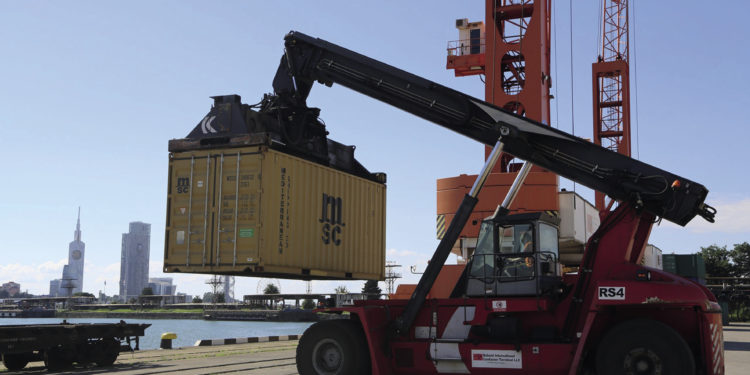The Silk Road Forum, a major biannual event, highlights Georgia’s historical role as a hub connecting Europe and Asia.
Georgia is a small country, but its location can substantiate this. Georgia has always been on the border of empires, and continents – Asia & Europe. This has both been an asset and a hinderance to the development of Georgia. A hindrance, because it attracted foreign invaders. An asset, because Georgia’s position allowed the country to periodically position itself as a transit territory between Europe and Central Asia.
Since 1991, a concept of the Silk Road has slowly been emerging on the borders Georgia. A closer look at historical documents from the ancient or medieval eras, or even the 15th-19th century, will reveal that this is true. The history of Georgia shows a pattern of major trade routes that run to the south, east, west and north of Georgia. These routes were connected to the outer Middle East and Central Asia. They also ran through the Russian hinterland. Rarely did the routes include Georgian land, and when they did, it was for a very short time. The geography of Georgia prevented transit through the country: the Caucasus Mountains, the seas, and the general lack of geographic knowledge over centuries.
After the dissolution of the Soviet Union in 1991, Georgia reclaimed its position between the Black Sea and the Caspian Sea, between Central Asia, and Eastern Europe. Georgian territory is now home to major roads, pipelines, and railway lines. Georgia is also expanding and building new and existing ports on the Black Sea. This could transform Georgia into an important sea trade hub.
The Silk Road Forum, a major biannual event held in Tbilisi every two years, is a good example of Georgia’s growing position on the Silk Road. The hosting of this event highlights how Georgia has recently enhanced its historical role as an interregional hub connecting Europe with Asia. On the map, this is the shortest route from China to Europe, which in turn could make the country a more attractive destination for foreign investments. Tbilisi can also benefit from the regional context, as Georgia has Free Trade Agreements (FTAs) with Turkey, CIS countries, EFTA, China, and a DCFTA, which includes a 2.3 billion-consumer market. The European business community can leverage these advantages in order to penetrate the far-flung areas of Central Asia and Middle East.
From a historical perspective, it is clear that the modern Silk Road concept, which originated in China, represents the greatest opportunity Georgia has ever had since the dissolution, in 1490, of the united Georgian monarchy, when major roads crossed the Georgian territory.
The newly constructed Baku-Tbilisi Kars (BTK), which runs from the Caspian Sea Port of Alat in eastern Turkey to the city Kars, was opened in 2017 at a ceremony by Azerbaijani President Ilham Aliyev and Turkish President Erdogan.
This project paved the way for improved connectivity, not only for the South Caucasus but also for Central Asian countries that are landlocked. The project opens up a rail corridor that could connect Central Asia to European markets via the South Caucasus.
Central Asia is important. Georgia and its infrastructure is crucial to reach the region. It is important to note that the shortest way to get freight from Central Asia to Europe is to cross the Caspian Sea to Azerbaijan and Georgia, then to the Black Sea. The steady growth in shipments from China is expected to boost the fragile South Caucasus energy and transport corridor, which is struggling to compete with other trade routes that go through Russia.
The progress made in Azerbaijan, and Georgia in the development of ports makes the Caspian Route more attractive. The infrastructure of the ports of Baku, and the small town of Alat has improved significantly over the last few years.
Along the rest of South Caucasus, similar trends of improving infrastructure can be seen. The Georgian Government granted APM Terminals permission to expand Poti Port. The project, which will create more than 1,000 local jobs, involves building a new multifunctional deep-water port.
The project is divided into two phases: the first phase, which will cost $250 million and take approximately 2.5 years to complete, will include the construction of a breakwater 1700 meters long and a quay measuring 13.5 meters deep. The second phase envisages a container quay of 300 meters. The expanded Poti port would be able to receive Panamax vessels, which is important for the infrastructure in the eastern Black Sea area and geopolitics.
Poti’s expansion will have regional implications. Poti is already the largest port in the country, and a major gateway for Azerbaijan’s and Armenian’s trade to Europe. Poti is the port of choice for liquids, passenger ferries and dry bulk traffic. Poti Port is also a route alternative for exports from Central Asia into the Black Sea.
Batumi is also undergoing similar developments. Wondernet Express Trammo, and the Government of Georgia have announced plans for a new terminal in 2019. The total investment cap is 17.5 million euros. The new facility can store tens thousands of tons of mineral fertilisers coming from Central Asia via Azerbaijan.
These trends in connectivity will reinvigorate Trans-Caspian Shipping, but there’s more to it, as Europe and Turkey want to break Russia’s grip on Central Asia gas export routes. Since the fall of the Soviet Union there has been support for the east-west route across the South Caucasus. But there have never been so many promising trends.
Emil Avdaliani: Analysis
Emil Avdaliani, a professor of European University, is also the Director of Middle East Studies for Geocase.
Read More @ georgiatoday.ge




